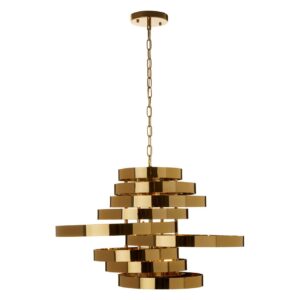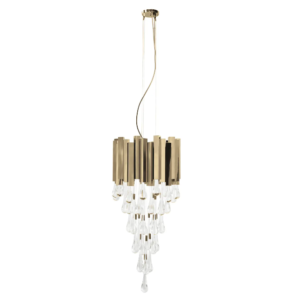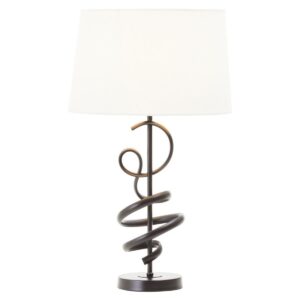Picture this: a room bathed in the soft glow of carefully placed lights, each fixture a piece of art in itself, casting shadows that dance along the walls. Lighting, often seen as a functional necessity, is in fact a transformative element in interior design. It has the remarkable ability to not only illuminate spaces but also to elevate ambiance, accentuate architectural marvels, and evoke emotions. In this exploration of sculptural lighting, we uncover its enchanting blend of functionality and artistic allure, turning ordinary rooms into captivating spaces that leave a lasting impression
-

North West
Alana 5 Bulb Gold Finish Pendant Lamp
£800 Add to cart -

Delightfull
NANCY WALL
£2,450 Add to cart -

Hamilton Barnes
Nikole Pendant Light
£90 Select options This product has multiple variants. The options may be chosen on the product page
The Transformative Power of Lighting in Interior Design
Lighting is often described as the soul of a space, capable of setting the mood, defining focal points, and shaping the overall atmosphere. Whether natural or artificial, the strategic use of lighting can dramatically alter the perception of a room, creating dynamic and visually engaging environments. From soft and intimate settings to bright and energetic spaces, lighting has the ability to evoke a range of emotions and responses from occupants.
One of the key strengths of lighting in interior design is its ability to enhance ambiance. By carefully selecting light fixtures, adjusting lighting levels, and utilizing different color temperatures, designers can tailor the mood of a space to suit its intended purpose. Warm, inviting lighting can make a living room feel cozy and welcoming, while cool, crisp lighting can create a sense of freshness and clarity in workspaces.
Moreover, lighting serves as a powerful tool for highlighting architectural features and design elements. Whether it’s illuminating a striking piece of artwork, emphasizing textured walls, or accentuating structural details like arches or columns, lighting draws attention to key focal points within a space. This not only adds visual interest but also enhances the overall aesthetic appeal of the environment.

Sculptural Lighting: Functionality And Artistic Expression
Sculptural lighting represents a marriage of functionality and artistic expression, where light fixtures transcend mere utility to become works of art in their own right. Unlike traditional lighting fixtures that simply provide illumination, sculptural lighting commands attention, sparks curiosity, and adds a unique dimension to interiors.
At its core, sculptural lighting is about creating visual interest and making a statement. These fixtures are designed to be more than sources of light; they are sculptural artworks that enhance the aesthetic value of a space. From intricate chandeliers that sparkle like jewels to minimalist pendant lights that exude modern elegance, sculptural lighting comes in a variety of forms, styles, and materials, each contributing to the overall design narrative of a room.
What sets sculptural lighting apart is its ability to capture attention and serve as a focal point within a space. These fixtures not only provide functional illumination but also serve as conversation starters, drawing admiration and curiosity from observers. Whether suspended from ceilings, integrated into architectural elements, or placed strategically to cast intriguing shadows, sculptural lighting adds a layer of intrigue and sophistication to interiors.
Types of Sculptural Lighting
-

Boca do Lobo
Lapiaz Table Lamp
£6,330 Select options This product has multiple variants. The options may be chosen on the product page -

Luxxu
Trump Pendant
£6,550 Add to cart -

Luxxu
Trump Wall Lamp
£2,650 Add to cart
Sculptural lighting transcends mere functionality, elevating spaces into realms of artistry and ambiance. This article delves into the captivating world of sculptural lighting, exploring its power to transform interiors with beauty and functionality. We will journey through various types of sculptural lighting, from the elegance of pendant lights to the grandeur of chandeliers and the versatility of floor lamps.
Pendant Lights
Pendant lights are veritable jewels in the crown of sculptural lighting. They come in diverse styles, each telling a unique design story. Geometric pendant lights offer a contemporary edge, with angular shapes and clean lines creating a modern aesthetic. Organic designs, on the other hand, mimic nature’s curves and flow, infusing spaces with a sense of fluidity and harmony. Minimalist pendant lights embrace simplicity, focusing on sleek forms and understated elegance.
Materials play a crucial role in sculptural pendant lights. Glass pendants exude a sense of transparency and lightness, casting enchanting patterns when illuminated. Metal pendants, whether in brushed steel, brass, or copper, add a touch of industrial chic or timeless sophistication. Wooden pendant lights bring warmth and organic charm, blending seamlessly with natural or rustic interiors.
Placement options for pendant lights are as diverse as their designs. They can serve as focal points over dining tables, casting a warm glow for intimate gatherings. In entryways, pendant lights welcome guests with a captivating first impression. As statement pieces in living rooms, they draw attention upward, adding vertical interest to the space.
Chandeliers
Chandeliers reign as the monarchs of sculptural lighting, commanding attention with their grandeur and elegance. Versatile in design and function, chandeliers can create dramatic lighting effects while adding a touch of luxury to interiors. Modern interpretations of chandeliers go beyond traditional crystal designs, embracing sculptural forms that redefine lighting as art.
Innovative materials and techniques breathe new life into chandeliers. Sculptural chandeliers may feature cascading metalwork, intricate glass patterns, or even organic elements like natural fibers or reclaimed materials. These modern interpretations blur the line between lighting fixture and art installation, becoming captivating focal points in contemporary spaces.

Floor Lamps
Floor lamps are not merely sources of illumination; they are sculptural artworks in their own right. Unique floor lamp designs blend form and function seamlessly, offering both visual appeal and practical lighting solutions. Adjustable features such as swivel heads or adjustable heights enhance usability, allowing users to customize lighting angles and intensity.
The beauty of sculptural floor lamps lies in their ability to complement various interior styles. From minimalist designs that add a touch of sophistication to eclectic pieces that become conversation starters, floor lamps contribute to the overall ambiance of a room. Their sculptural forms create visual interest, whether they stand alone as artistic statements or harmonize with existing decor elements.

Sculptural Lighting in Different Spaces
In different spaces, sculptural lighting not only illuminates but also elevates. It adds depth, character, and a touch of artistry, transforming ordinary rooms into extraordinary realms of beauty and ambiance. Whether it’s creating a focal point in the living room, setting an intimate mood in the dining area, or infusing serenity and style in the bedroom, sculptural lighting showcases the power of light as a design element that transcends mere functionality.
Living Room: A Focal Point of Elegance
The living room serves as the central hub of activity, where family and friends converge for relaxation and socialization. Sculptural lighting in this space transcends mere illumination; it becomes a beacon of elegance and style. Imagine a contemporary pendant light, its intricate design casting a mesmerizing pattern of light and shadow across the room. Such lighting not only complements the furniture arrangements but also defines the room’s aesthetic, making it a focal point that captivates attention and sparks conversation.
Beyond aesthetics, sculptural lighting in the living room plays a functional role in creating different zones within the space. For example, strategically placed floor lamps can define a cozy reading nook or accentuate a statement piece of furniture. This interplay of light and form not only enhances the overall ambiance but also adds depth and visual interest to the room.
Bedroom: Serenity and Style
The bedroom is a sanctuary of rest and rejuvenation, where sculptural lighting transforms ordinary moments into serene experiences. From bedside table lamps to wall sconces and ceiling fixtures, the bedroom offers a canvas for artistic illumination. Picture a minimalist bedside lamp with a sculptural base, casting a soft and soothing glow that creates a tranquil ambiance perfect for winding down at the end of the day.
In addition to functionality, sculptural lighting in the bedroom serves as a design element that enhances the room’s overall style. Wall-mounted sconces can double as decorative accents, adding visual interest to blank walls while providing ambient lighting. Ceiling fixtures, such as modern pendant lights or chandeliers, contribute to the room’s aesthetic by creating a focal point or complementing existing decor themes.

Dining Area: Intimate Illumination
The dining area is a realm of culinary delights and shared moments, where lighting sets the mood for intimate gatherings and festive feasts. Here, chandeliers and pendant lights reign supreme, infusing the space with a touch of grandeur and sophistication. A carefully chosen chandelier, suspended elegantly above the dining table, becomes the centerpiece of the room, casting a warm and inviting glow that enhances the dining experience.
When considering sculptural lighting for the dining area, factors such as lighting levels, positioning, and scale come into play. The height at which the lighting fixture is installed, its size relative to the dining table, and the type of light it emits all contribute to creating the desired ambiance. Whether it’s a cascading cluster of pendant lights or a contemporary chandelier with adjustable brightness, sculptural lighting in the dining area adds an element of luxury and creates a memorable atmosphere for shared meals and conversations.
Installation and Placement Tips
Sculptural lighting can be effectively installed and placed to enhance the beauty and functionality of interior spaces. Striking the right balance between aesthetics and practicality ensures that sculptural lighting becomes a captivating focal point while harmonizing with the overall design scheme of the room
Considerations for Ceiling Height
Choosing the right fixture size in relation to ceiling height is crucial for achieving a harmonious and visually appealing lighting arrangement. Here are some guidelines to consider:
- Low Ceilings: Opt for flush mount or semi-flush mount fixtures that hug the ceiling closely, providing adequate illumination without overwhelming the space. Avoid pendant lights or chandeliers with long drops that may create a crowded or cramped feel.
- Standard Ceilings: For standard ceiling heights, pendant lights, chandeliers, and ceiling-mounted fixtures are suitable choices. Ensure that the fixture’s proportions complement the room’s scale, neither dominating nor getting lost in the space.
- High Ceilings: Embrace the verticality of high ceilings by selecting larger or more dramatic fixtures such as grand chandeliers or statement pendant lights with extended drops. These fixtures draw the eye upward, adding a sense of grandeur and spaciousness to the room.
Room Size and Layout
The size and layout of the room significantly influence where and how sculptural lighting should be placed. Consider the following factors:
- Open Plan Spaces: In open-plan layouts, use sculptural lighting to delineate different zones or areas within the space. For example, a large pendant light or chandelier can define the dining area in an open-concept kitchen and dining room.
- Functional Zones: Identify key functional areas such as seating areas, dining spaces, or focal points like artwork or architectural features. Place sculptural lighting strategically to highlight these areas while maintaining a cohesive lighting scheme throughout the room.
- Traffic Flow: Ensure that the placement of lighting fixtures does not obstruct traffic flow or impede movement within the room. Opt for fixtures with appropriate clearance and consider adjustable options for flexibility in directing light.
Existing Decor Integration
Integrating sculptural lighting seamlessly into existing decor styles enhances coherence and harmony within the space. Here are strategies to achieve a unified look:
- Style Compatibility: Match the style of sculptural lighting fixtures with the overall decor theme. For example, modern and contemporary fixtures complement sleek and minimalist interiors, while ornate or vintage-inspired fixtures enhance traditional or eclectic decor.
- Color and Material Coordination: Consider the color palette and materials used in the room’s decor when selecting lighting fixtures. Choose finishes and materials that complement existing furnishings, creating visual continuity and a cohesive design scheme.
- Layering with Other Lighting: Combine sculptural lighting with ambient, task, and accent lighting to create layered illumination that enhances functionality and ambience. Coordinate different light sources to create depth and dimension in the room.

Impact on Interior Design
Sculptural lighting is a dynamic element in interior design, merging functionality with artistic expression to illuminate spaces in captivating ways. By harnessing the power of sculptural light fixtures, designers can create immersive environments that captivate the senses and enhance the overall aesthetics and functionality of a space.
Visual Impact
Sculptural lighting serves as a visual focal point, drawing attention and adding dimension to interior spaces. By strategically placing sculptural light fixtures, designers can create layers of light that enhance depth, highlight architectural features, and emphasize textures. For example, pendant lights with intricate designs can cast intricate shadows, while chandeliers with cascading crystals create a dazzling play of light and shadow. Additionally, sculptural lighting fixtures made from innovative materials such as sculpted metal, blown glass, or organic elements like wood or stone can contribute to a unique visual identity in a room.
Emotional Response
The lighting ambiance created by sculptural fixtures influences the emotional atmosphere of a space. Soft, warm lighting can evoke a sense of comfort and intimacy, making living areas inviting and cozy. In contrast, cooler tones or dramatic lighting effects can add a touch of sophistication and drama, setting the mood for elegant dining experiences or stimulating creative thinking in workspaces. The interplay of light and shadow created by sculptural lighting can also evoke different emotions, from tranquility to excitement, depending on the design intent and context of the space.
Spatial Perception
Well-placed sculptural lighting can significantly impact the perceived size and dynamics of a room. Strategically placed light sources can visually expand smaller spaces, making them appear more open and airy. Conversely, targeted lighting can create zones within larger areas, defining specific functions or creating intimate settings within a larger room. For example, accent lighting focused on artwork or architectural details can draw the eye and create visual interest, while ambient lighting diffused through sculptural fixtures can create a sense of continuity and harmony throughout the space.
Maintenance Tips For Sculptural Lightning
Maintaining sculptural lighting fixtures is crucial to preserving their beauty and functionality over time. Here are some practical tips for cleaning and upkeep:
Regular Cleaning: Dust and dirt can accumulate on lighting fixtures, affecting their brightness and appearance. Use a soft cloth or a feather duster to gently remove dust from the surface of the fixtures. Avoid using abrasive cleaners or harsh chemicals that may damage the finish.
Cleaning Glass Elements: If your sculptural lighting includes glass elements such as shades or covers, use a mild glass cleaner and a soft cloth to clean them. Be gentle to avoid scratching or streaking the glass. For intricate designs or textured glass, consider using a brush with soft bristles to reach crevices.
Check for Loose Parts: Periodically inspect your sculptural lighting fixtures for any loose parts or connections. Tighten screws, bolts, or fasteners as needed to ensure stability and safety. Check electrical connections for signs of wear or corrosion and address any issues promptly.
Adjust and Align: Over time, lighting fixtures may become slightly misaligned or tilted. Regularly check and adjust the alignment of pendant lights, chandeliers, or other suspended fixtures to ensure they hang straight and level. Proper alignment not only enhances aesthetics but also improves lighting performance.
Professional Inspection: For complex or integrated lighting systems, consider scheduling a professional inspection and maintenance service annually. Qualified technicians can assess the condition of wiring, electrical components, and overall functionality, addressing any potential issues before they escalate.
Protect from Environmental Factors: If your sculptural lighting fixtures are installed in outdoor or semi-outdoor spaces, take precautions to protect them from environmental factors such as rain, humidity, and direct sunlight. Use weatherproofing treatments or covers designed for outdoor lighting to extend their lifespan.
Whether it’s creating a dramatic statement in the living room, adding a touch of luxury to the dining area, or infusing tranquility into the bedroom, sculptural lighting offers endless possibilities. Embrace creativity, push boundaries, and let sculptural lighting be the beacon that transforms your space into a visually stunning and emotionally captivating environment.







